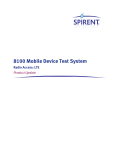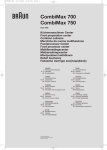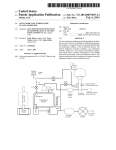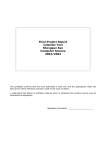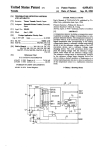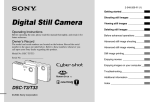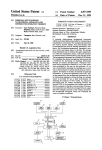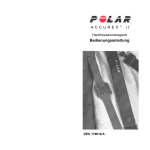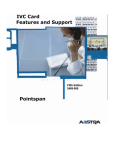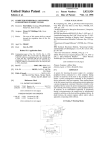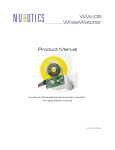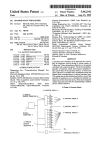Download (x 9/9
Transcript
Us005450325A
United States Patent [191
[11]
Patent Number:
5,450,325
Rodriguez
[45]
Date of Patent:
Sep. 12, 1995
[54]
5,243,528
ROUTE DIRECTIONS DISPLAY SYSTEM
[76] Inventor:
Angel L. Rodriguez, 4219 Baker Ave.
I] ' " Seattle’ Wash‘ 98107
OTHER PUBLICATIONS
User manual for Polar CycloVantage, describing com
[21] Appl. No.: 848,308
.
9/1993 Lefebvre ........................... .. 364/449
munication between Cyclocomputer and general pur~
_
pose computer, 1989.
[22] F?ed'
Mar‘ 9’ 1992
Pp. 66-70 from Jan., 1991, issue of American Bicyclist,
[51]
Int. Cl.6 ............................................ .. G06F 15/50
showing features of currently available Cyclocomput
[52]
US. Cl. .................................. .. 364/444; 364/443;
erg,
364/424.01; 340/995
[5 8] Field of Search .................... .. 364/424.01, 424.04,
364/443, 444, 449, 468, 460, 561, 708, 709.1;
340/995
References Cited
[56]
U.S. PATENT DOCUMENTS
.
.
.
5mm %”m"?e"'§evm {?fskg
“mm “WW-i “San ‘e an
Attorney, Agent, or Fzrm—-Graybeal Jackson Haley &
Johnson
[57]
ABSTRACT
.
_
.
A cyclocomputer for use on a bicycle displays route
3,898,563 8/1975 Erisman ............................ .. 324/166
instructions stored in the cyclocomputer, displays two
4,007,419
dimensional graphs on the face of the cyclocomputer,
Jasmine . . . . . . . . . 1 . . .
. . . . ..
4,156,190
5/1979
Chittenden et al. ..
.... .. 324/175
4,507,737
3/1985
LaSarge et a1. ..... ..
364/453
a“
340/995
to
4,531,123 7/1985 Tagami et 81' u"
4,570,227
2/1986
Tanchi et a1, , _ _ _ ,
_ _ , , ,_ 364/444
4,638,448
1/ 1987 Cuvelier et a1. ..
d .
b1
‘5 “Pa
f
on.
6 ° exp
mg
and .
rt.
. f0
ImP° mg 1“
{0
ma 1 n
from other computers 01' cyclocomputers. The
route instructions may be displayed with symbols such
364/565
as left arrow, right arrow and up arrow or with alpha
4,682,237 7/ 1937 MiZImO et a1.
364/561
numeric characters. The displayed instruction is ad
4’774’671
364/449
vanced to the next instruction automatically when a
4’819’174 ‘V1989 Funmo et a1‘
364/444
predetermined distance has been measured by the
4,862,395 8/1989 Fey et a]. .... ..
4,881,187 11/1989 Read ................ ..
364/561
364/565
d
t
b th
f b tt
B a
0 (‘me er of y ‘ipress ° _3 ‘1 °n_‘ ‘1 0,“ Presses
272/73
may advance or review the displayed instructions. The
9/1983 “"11 at al- -------- '~
4,976,424 11/1990 Sargent et aL ____ __
4,977,509 12/1990 Pitchford er a1,
364/449
distance to the next instruction point is constantly dis
4,992,947 2/1991 Nimura et a1. ...... ..
364/444
played. Importing information may be accomplished
4,999,783 3/1991 Tenmoku 6! al--
364/450
with an infrared link which communicates to many
540164007 5/1991 Iihoshi at 31'
364/449
cyclocomputers at one time. Recorded data, such as
g’gié’égg
3:3: ‘2;;
speed, pedal cadence, or heart rate, may be displayed
5:121:326 5/1992 Morozo et a1. .11.:
364/449
5,172,321 12/1992 Ghaem et a1.
364/444
5,177,685
1/1993
364/443
5,213,555
5/1993 Hood et a]. ......................... .. 482/57
4
3
l
Davis et al. ..... ..
g‘é‘iztwith the graphs being marked for
'
26 Claims, 8 Drawing Sheets
SPEED 15
5
NEXT TURN .4
E
1.2 R STONE WAY
E
D
6
(x 9/9
\21/
8
US. Patent
'
Sep. 12, 1995
FIG. I
Sheet 1 of 8
F
"*
“
SPEED l5
NEXT TURN .4
|.2 R STONE WAY
21/
8
FIG. 2
5,450,325
5
US. Patent
Sep. 12, 1995
FIG. 3
Sheet 2 of 8
5,450,325
U.S. Patent
Sep. 12, 1995
Sheet 3 of 8
FIG. 5
USER
BUTTONS
BI, B2, B3
WHEEL
ROTATION
SENSOR
DATA
BUS
CPU
I /O
CONTROL
ROM
ELECTRICAL
I/O PORT
RAM'
INFRARED
RECEIVER
INFRARED
TRANSMITTER
5,450,325
DISPLAY
US. Patent
Sep. 12, 1995
Sheet 8 0f 8
5,450,325
FIG. IO
USERBUTTONS
PRESSEDTOACTIVATE
DISPLAY CURRENT
SPEED, DISTANCE
AUTOMATIC ROUTE
TONEXT TURN AND
INSTRUCTIONS?
STARTING INSTPUCTION
UPDATE SPEED
AND DISTANCE
TO NEXT TURN
TIME TO BEEP
AND DISPLAY NEXT
BEEP AND
DISPLAY NEXT
INSTRUCTION?
INSTRUCTION
1
5,450,325
ROUTE DIRECTIONS DISPLAY SYSTEM
BACKGROUND OF THE INVENTION
This invention relates to an improvement for low
power electronic microcomputer odometer/speedome
ters for bicycles which allows the devices to display
route directions.
State of the art odometer/speedometer devices for
bicycles are wrist watch size devices with wire connec
tions to small sending units which sense revolutions of a
wheel. The device includes an electronic clock for cal
culating speed. The history of development of these
odometer/speedometer devices for bicycles is de
scribed in US. Pat. No. 4,156,190. US. Pat. No.
4,638,448 describes some of the more recently invented
features of such devices.
According to contemporary bicycle industry maga
zines, these devices are now referred to as “cyclocom
puters”. Data that can be displayed on various cy
clocomputers includes: current speed, maximum speed,
average speed, total distance, trip distance, total time,
trip time, clock time, stop watch functions, and count
2
municated from another computer, either a general
purpose computer or another cyclocomputer.
Because each instruction point is associated with a
distance number and the odometer is measuring dis
tance, the cyclocomputer is preferably programmed to
display the remaining distance to the next instruction
point. In addition, the preferred cyclocomputer pro
gram generates a prompt at a certain predetermined
time from the next instruction point using the bicycle
speed and the distance remaining to calculate the time.
In alternative embodiments, the prompt may be in the
form of a visual one on the display, an audio voice cue,
or other sensory signal.
Once a set of route instructions with distance num
bers is loaded into the cyclocomputer, the wheel size
calibration number stored in the memory of the cy
clocomputer can be revised to be more accurate upon
command from the rider. If, when the rider reaches an
instruction point after the starting point, the next in
struction does not appear automatically at the correct
point, the rider can press buttons to instruct the cy
clocomputer to consider the distance traveled to be the
same as the distance number from the instruction set
and recalibrate the correct wheel size accordingly. The
down timer. With additional internal electronics, some 25 same feature can be used to empirically calibrate the
cyclocomputers can also display altitude, rate of climb
or descent, and temperature. With additional sensors
located at the crank or on the rider, some cyclocomput
ers can display pedaling cadence, whether cadence is
above or below a set point, heart rate, whether heart
rate is above or below a set point, and total time that
heart rate is within target zones. Various cyclocomput
ers feature audio beeps or synthesized voice cues to
report some of this information to the rider. Various
cyclocomputers can record any of the above data and
replay the recorded data on the instrument face. At
least one of them can also export this data to a computer
for further analysis or display. The odometer function
of each cyclocomputer requires calibration to the wheel
size of the bicycle. This is accomplished by pressing
buttons on the cyclocomputer, and either riding the
bicycle over a measured distance or inputting the wheel
size.
Many cyclists tour for pleasure and enjoy discovering
new routes that they have not previously ridden. Cy
cling clubs and cycling magazines frequently publish
wheel size by entering a set of route instructions with
two instruction points a known distance apart, such as
one mile, and then riding the known distance, typically
a measured mile along a road or bicycle path. Appropri
ate button presses at the beginning and end of the mea
sured distance will produce a highly accurate, empiri
cally measured, wheel size calibration.
The invention also allows route instructions and dis
tance numbers for each instruction to be imported from
a general purpose computer or another cyclocomputer.
In an alternative embodiment, wheel size calibration
information may also be imported. The importing link
may be established with electrical wires between the
devices or by electromagnetic communication, such as
infrared or radio. In a preferred form of the invention
infrared is employed, and the information can be im
ported to many cyclocomputers at one time all in close
proximity to the transmitter for loading a batch of cy
clocomputers all with the same route instructions.
45
Another aspect of the invention allows information
such as distance numbers associated with each instruc
route descriptions, either in map form or a sequence of
tion point, route instructions, and data gathered from a
written instructions, for others to follow. The cyclist
typically carries the instructions in paper form in a
ride, such as speed/time or altitude/distance, to be ex
ported from a cyclocomputer to a general purpose com
pocket and occasionally stops to consult the instruc
puter for editing, analysis, display, or re-exporting to
tions, an inconvenient process.
other cyclocomputers. The information transfer can
also be made directly from one cyclocomputer to an
other.
The present invention displays biking route instruc
A still further aspect of the invention allows data
tions on the screen of the cyclocomputer. The displayed 55 contained within the cyclocomputer to be displayed in
instruction is advanced to the next instruction by auto
a two dimensional graph on the face of the computer,
SUMMARY OF THE INVENTION
matic means such as when an odometer measures a
by the use of an x y coordinate addressable LCD dis
certain distance from the last instruction point or from
play. The locations of points associated with each route
the start of the route, or by user activated control such
instruction are displayed on the graphs.
as a command button. The distance number for trigger 60
BRIEF DESCRIPTION OF THE DRAWINGS
ing the automatic display of the next route instruction
can be entered by pressing buttons on the cyclocom
puter, by recording a number measured by the odome
FIG. 1 is a front elevation of a cyclocomputer with a
screen displaying an instruction, the distance to the next
ter when the route is ridden by the route designer and a
instruction point, and the current speed. It also shows a
button is pressed at the instruction point, or by import 65 form of wire connection to either a general purpose
ing the distance numbers for a predesigned route from
computer or another cyclocomputer.
another computer. The route instructions may be en
tered at the cyclocomputer with button presses or com
FIG. 2 is a view of an alternative embodiment of the
cyclocomputer of FIG. 1 with the screen showing a
3
5,450,325
two dimensional graph of speed over time. The graph is
marked to show each instruction point. The embodi
ment of FIG. 2 also shows a sensor/transmitter window
for communicating via infrared radiation with another
4
left arrow, and a straight up arrow as a set of designa
tions which is simple to scroll through and select.
Whether the route instructions are created at the
cyclocomputer or imported from another computer, the
number of instructions is limited only by the available
memory in the cyclocomputer.
In the preferred embodiment, the cyclocomputer
general purpose computer or cyclocomputer,
FIG. 3 shows a plurality of cyclocomputers like that
shown in FIG. 2 positioned for receiving instructions or
other data simultaneously from a single infrared trans
includes a feature which allows the distance from one
instruction point to the next to be measured when the
route is ridden by the route describer. See FIG. 8. The
route describer pushes a button at each instruction point
to record in the memory of the cyclocomputer the
distance from the last instruction point and/or the total
mitter connected to a personal computer.
FIG. 4 shows the wheel rotation sensor including a
magnet and magnetic sensitive reed switch.
FIG. 5 shows a block diagram of the electronic com
ponents. It is a typical design for a cyclocomputer ex
distance from the starting point. This data on distances
cept for the addition of the infrared receiver and trans
15 for each instruction point may then be exported to the
mitter.
FIG. 6 shows the use of user control buttons B1 and
B2 to access the principal functions and some subsidiary
functions of the cyclocomputer. B1 indicates a press of
the ?rst user button and B2 indicates a press of the
20
second user button.
FIG. 7 shows the use of user control buttons B1, B2,
and B3 to access the subsidiary functions within the
general purpose computer for editing and formatting to
create a complete set of route instructions. The instruc
tion point distance numbers and/or the instructions may
also be transferred from one cyclocomputer to another.
Once a cyclocomputer is loaded with the route in
structions, the rider initiates the ride with the push of a
button 2. See FIG. 7. The computer displays the ?rst
ride instruction, typically a starting location. The rider
again pushes a button 2 when the bicycle is at that loca
Instructions function. B3>< 2 indicates two quick presses
in succession of button B3, and B2 3 sec. indicates a 25 tion to start the trip odometer at zero. At any point, if
three second press of button B2.
the rider takes a side trip or a shortcut, or if the distance
FIG. 8 shows the use of user control buttons to access
measurement from either the odometer or the stored
all of the subsidiary functions within the Record func
route instructions is inaccurate, the rider can reset the
tion.
trip odometer to the appropriate point by pressing a
FIG. 9 shows the use of user control buttons to access
all of the subsidiary functions within the Setup function.
FIG. 10 shows the logic flow for the display and
updating of route instructions.
DETAILED DESCRIPTION
button 2 when the bicycle is along side an instruction
point.
If the rider believes that the route instructions contain
an accurate distance and his wheel size calibration is
inaccurate, he can press a button which instructs the
35 cyclocomputer to recalibrate the wheel size so that the
In the preferred embodiment, route instructions are
reported odometer distance will match the distance
edited and formatted on a personal computer to appear
stated in the route instructions. See FIG. 7.
To tell the rider when the next instruction point will
as line by line instructions on the cyclocomputer 1. For
a cyclocomputer that can display 25 characters on a
be reached, in the preferred embodiment, the display
line, an example of an edited set of route instructions as 40 indicates the distance remaining to the instruction point
3. One can watch this number approach zero and be
it appears on the screen of a personal computer would
forewarned accordingly. See FIG. 10. Also, the device
be:
will make a warning sound one or more preset times
DUCKS RIDE
0.0
0.0
1.2
3.4
5.6
6.8
11.7
ST
L
R
C
L
RY
R
GAS WORKS PARK
PACIFIC AV N
STONE WAY
STONE WAY
50TH ST
PHINNEY AV
YESLER WY
12.1
*
GOOD EATS HERE
13.7
15.8
19.6
X
R
L
GREEN LAKE WY N
N 34TH ST
GAS WORKS PARK
45
(calculated with current speed 4) from the instruction
point. Alternatively, the device might play a synthe
sized voice prompt to alert the rider that an instruction
point is coming up soon and it might further state the
turn instructions in a synthesized voice, such as “right”
or “left”. In an alternative embodiment, the prompt
50 which indicates that an instruction point is approaching
is based on remaining distance rather than remaining
time.
In the preferred embodiment, once the instruction
point is reached as measured by the odometer, the next
55 instruction will automatically appear. See FIG. 10.
Alternatively, if the cyclocomputer has no odometer
In the above example, ST means start, R means turn
function or the odometer is not working, the arrival at
right, L means turn left, RY means go right at the Y, X
an instruction point can be communicated by the rider
means cross, C means continue, and asterisk means
to the cyclocomputer by the press of a button 2, thereby
point of interest.
advancing to the next instruction. See FIG. 7. At any
The buttons on the cyclocomputer 2 can be used to
time, the rider can scroll forward or backwards through
generate all the characters required for the route in
the instructions, by pressing buttons.
structions. Because it is inconvenient for the user to
Using an LCD display, the screen of the cyclocom
scroll through 40 different alpha numeric characters,
puter is addressable with x and y coordinates. Alterna
when selecting the direction abbreviation designation as 65 tive embodiments can be built with a gas plasma display
shown above (R, L, ST, RY, LY, X, or C), the interface
scrolls through merely this list of designations. An alter
or any other small, flat panel display technology. Dur
ing a ride, the cyclocomputer records time and distance
native embodiment might simply allow a right arrow, a
as well as information about the ride such as speed,
5
5,450,325
6
cadence, and, with appropriate sensors, heart rate, alti
tude, or temperature. Using the x y addressable display,
small electronic devices. Infrared transmitting and re
ceiving windows are well known in small electronic
any of these items can be displayed over time or over
devices as are plugs and jacks for connecting multiple
wires for direct wire connection. Microprocessors and
distance. Each of the instruction points 5 shows on the
graph. The data from any number of rides remains
non-volatile memories are well known in cyclocomput
ers and other electronics. Programming of the features
stored in the cyclocomputer for later display or export
ing, limited only by memory. When the graph is dis
played, the programmed logic chooses an appropriate
scale with appropriate starting points and ending points
and the computations required to implement the above
described features is straight forward and could be ac
complished by any trained programmer. Placement of
voice synthesizer electronics and a speaker is described
in US. Pat. No. 4,638,448.
for each axis. The selected scales are then displayed 8.
In an alternative embodiment, the cyclocomputer
might be designed so that trip data can only be accumu
lated in the cyclocomputer from an actual ride and not
The preferred embodiment for the cyclocomputer is
relatively small, with a screen of about 2" by 1", and a
small number of buttons, as shown in FIGS. 1 and 2. It
is created with existing components and a custom made
case. An alternative embodiment has been created using
by pressing of buttons or importing from a computer.
Then each cyclocomputer could be used to record in
formation from competitions and officials who are not
riding in the race would not be required.
a pocket sized general purpose computer with an x y
At the end of a ride, whether a pleasure tour, a train
ing ride, or a competition, recorded data from the ride
addressable LCD display, speci?cally, the Hewlett
competitors to determine winners. Another would be
the creation of a personal tour log or training record. A
third might be to modify the route instructions or dis
Packard I'IP95LX. The computer has been pro
grammed to communicate through an RS 232 serial port
to the reed switch 12 for counting wheel rotations. For
importing or exporting data, the HP95LX has an infra
red communications window.
Some of the uses of the disclosed cyclocomputer
25
tance numbers for subsequent importing to one or more
cyclocomputers for future rides on the same route.
local bike shop to import into their cyclocomputer one
can be exported to a computer to be manipulated or 20
analyzed for various purposes. See FIG. 9. One such
purpose might be the comparison of data from various
In the preferred embodiment, at least two lines are
available for route instructions so the instructions 1 can
be long and detailed. If the instruction or similar com
ment is longer than this, or in an alternative embodi
ment, where only one line is available, additional lines
of an instruction can be displayed by pressing a button
2.
include the following. Riders in a new area may go to a
or more routes to ride. Book publishers may include a
disk with routes ready to load into a general purpose
computer and export to the cyclocomputer. Bicycle
tour companies may export the day’s ride to all of the
tour participants. Bicycle clubs may publish recom
mended rides on a computer bulletin board for import
ing into a general purpose computer with a modem and
Communication with other general purpose comput 35 then exporting to the cyclocomputer. To promote bicy
cle tours, government tourism departments may send
prospective visitors route descriptions on disk. Friends
may share routes that they have developed. Magazines
ers or cyclocomputers for exporting or importing infor
mation can be accomplished either with a multiple wire
connection 6 or by radio or infrared electromagnetic
radiation. The preferred embodiment uses infrared
which is transmitted and received with an I/R photo
emitter diode and an I/R sensor diode located behind a
may publish routes in a printed format suitable for entry
into a general purpose computer or directly into a cy
clocomputer.
Numerous alterations and modi?cations of the em
bodiments described above will become apparent to
those skilled in the art after having read the above dis
vision transmitters and other communications between
devices such as electronic name, address and telephone 45 closure. It is therefore intended that the following
claims be interpreted to cover all such alterations and
number record systems. Using infrared means, commu
modi?cations as fall within the true spirit and scope of
nication between cyclocomputers can be accomplished
the invention.
by placing them adjacent to each other. In addition, an
I claim:
infrared transmitter 9 plugged into an RS 232 serial port
1. An odometer for use on a wheeled vehicle com
of a general purpose computer 10 can be placed in a
prising:
location where it can transmit to many bicycle cy
(a) means for sensing each rotation of a rotating part
clocomputers all at one time, allowing all of the cy
which rotates a ?xed number of times with each
clocomputers to be loaded with route descriptions all at
one time.
rotation of a Wheel;
small window on the cyclocomputer 7. Such infrared
communication means are well known for remote tele
In the preferred embodiment, the cyclocomputer can 55
be set so that importing from a computer requires a
password to prevent others from intentionally or inad
vertently changing the route instructions or other
stored information in the cyclocomputer.
All of the components required to build the invention
are well known. Wheel rotation and crank rotation
sensors, preferably consisting of a magnet 11 mounted
on the spokes and a reed switch 12 mounted on the
(b) means for counting sensations of rotation;
(0) means for causing the odometer to begin counting
sensations of rotation;
(d) means for inputting to the odometer the distance
travelled from the commencement of counting
sensations of rotation; and
(e) means for using the distance travelled and number
of rotations counted over that distance to subse
quently calculate a second distance travelled from
forks, are widely available in the market place, as are
a second counted number of sensations of rotation.
heart rate, temperature, and altitude sensors. All of 65
2. A device for storing predetermined route instruc
these have been incorporated into cyclocomputers that
tions and communicating them to a bicycle rider, com
are widely available. X Y addressable LCD displays are
prising:
commonly available in pocket calculators and other
(a) a housing for mounting on a bicycle;
7
5,450,325
8
(b) means within the housing for storing the predeter
15. The device of claim 14, wherein the importing
mined route instructions and, associated with each
means comprises:
(a) a plurality of electrical wires.
route instruction, a distance value;
(c) means within the housing for communicating a
16. The device of claim 14, wherein the importing
5 means comprises:
predetermined route instruction to the rider;
(a) transmitting means, coupled to the computer, for
(d) odometer means;
(e) means for comparing the stored distance value
transmitting electromagnetic radiation through
with distance measured by the odometer; and
free space; and
(t) means for advancing the communicated instruc
(b) means, coupled to the cyclocomputer, for receiv
tion to the next predetermined route instruction
ing the transmitted velectromagnetic radiation.
when the comparison between the measured dis
17. The device of claim 2, further comprising:
tance and the stored distance value reaches a cer
(a) importing means for importing information from a
tain number.
.
computer; and
3. The device of claim 2 wherein the means for com
(b) storage means for storing the imported informa
municating the route instruction comprises:
15
tion.
(a) means for announcing an audio instruction.
18. The device of claim 17, wherein the importing
4. The device of claim 2 wherein the housing has a
means comprises:
display and the means for communicating the route
(a) transmitting means, coupled to the computer, for
instruction comprises:
transmitting electromagnetic radiation through
(a) means for displaying the communicated instruc 20
free space; and
tion on the display.
(b) means, coupled to the storage means, for receiv
5. The device of claim 2, further comprising:
ing the transmitted electromagnetic radiation.
(a) means responsive to the odometer for calculating
19. The device of claim 17, wherein the information
the current speed;
comprises:
(b) means for calculating the remaining distance to 25
(a) information for calibrating an odometer function
the next instruction point; and
to the wheel size.
(c) means for calculating and communicating the
20. The device of claim 17, wherein the information
remaining time to the next instruction point at the
comprises:
current speed.
(a) route instructions.
' 6. The device of claim 5, wherein the means for com 30
21. The device of claim 17, wherein the importing
municating the remaining time to the next instruction
means comprises:
point comprises:
(a) a plurality of electrical wires.
(a) means for announcing one or more sounds at one
22. A cyclocomputer for a bicycle comprising:
or more predetermined times prior to expected
(a) a display to present two dimensional graphs show
arrival at the next instruction point at the current 35
ing variation of one of the variables, speed, altitude,
speed.
7. The device of claim 5, wherein the housing has a
display and the means for communicating the remaining
time to the next instruction point comprises:
(a) means for displaying on the display one or more
visual symbols at one or more predetermined times
cadence, heart rate, and air temperature as a func
tion of one of: (1) time elapsed and (2) distance
travelled by the bicycle on the face of the cy
clocomputer; and
(b) means for displaying on the graphs a plurality of
point locations each associated with a route in
struction.
23. The device of claim 22, further comprising:
(a) means for storing a sequence of predetermined
prior to expected arrival at the next instruction
point at the current speed.
8. The device of claim 2, further comprising:
(a) means for calculating and communicating the 45
route instructions;
remaining distance to the next instruction point.
(b) means for displaying a predetermined route in
9. The device of claim 8, wherein the housing has a
struction on the face of the cyclocomputer; and
display and the means for communicating the remaining
(0) means for advancing the displayed predetermined
distance to the next instruction point comprises:
instruction to the next predetermined instruction.
(a) means for displaying on the display the remaining
24. A device comprising the combination of a cy
distance to the next instruction point.
clocomputer with:
10. The device of claim 2, further comprising:
(a) a communication link to import information from
(a) means for obtaining from the odometer a mea
sured distance value and storing it as the stored
distance value.
55
11. The device of claim 10, further comprising:
(a) means for entering route instructions and storing
them as the stored route instructions.
12. The device of claim 11, further comprising:
(a) means for exporting the stored route instructions 60
to a computer.
13. The device of claim 10, further comprising:
(a) means for exporting the stored distance values to
a computer. 1
14. The device of claim 2, further comprising:
65
(a) importing means for importing route instructions
from a computer to be stored in the route instruc
tions storage means.
a computer to be stored in the cyclocomputer, the
information comprising information for calibrating
an odometer function to the wheel size, the com
munication link including:
(a1) a plurality of electrical wires;
(a2) transmitting means, coupled to the computer,
for transmitting electromagnetic radiation
through free space, the transmitting means fur
ther including means for transmitting to a plural—
ity of receivers all at one time; and
(a3) means, coupled to the cyclocomputer, for
receiving the transmitted electromagnetic radia
tion.
25. A device for storing a sequence of predetermined
route instructions and communicating them to a bicycle
rider, comprising:
5,450,325
10
(a) a housing for mounting on a bicycle;
(0) means Within the housing for communicating a
(b) means within the housing for storing the predeter
predetermined route instruction to the rider;
(d) means for advancing to the next predetermined
route instruction, the means for advancing the in
mined route instructions;
(c) means within the housing for communicating a
predetermined route instruction to the rider; and 5
(d) means for advancing to the next predetermined
route instruction;
(e) importing means for importing information from a
computer, the importing means including:
10
(e1) transmitting means, coupled to the computer,
for transmitting electromagnetic
radiation
through free space; and
with each route instruction;
(d3) means for comparing the stored distance value
with distance measured by the odometer and
producing a comparison value; and
(d4) means for advancing the communicated in
struction to the next instruction when the com
parison value reaches a certain number; and
(e) importing means for importing route instructions
(e2) means, coupled to the storage means, for re
ceiving the transmitted electromagnetic radia
tion; and
(t) storage means for storing the imported informa
tion.
from a computer to be stored in the route instruc
tions storage means, the importing means includ
mg:
(e1) transmitting means, coupled to the computer,
for transmitting electromagnetic radiation
26. A device for storing a sequence of predetermined
route instructions and communicating them to a bicycle
rider, comprising:
struction including:
(d1) odometer means;
(d2) means for storing a distance value associated
through free space to a plurality of receiver
'
means all at one time; and
(a) a housing for mounting on a bicycle;
(b) means within the housing for storing the predeter
25
mined route instructions;
35
45
55
60
65
(e2) means, coupled to the cyclocomputer, for
receiving transmitted electromagnetic radiation.
*
*
*
*
*














